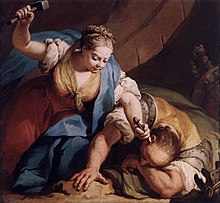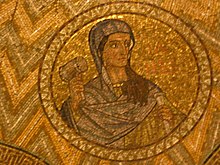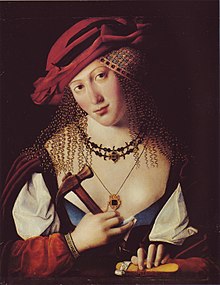Jael
 From Wikipedia - Reading time: 14 min
From Wikipedia - Reading time: 14 min
Jael | |
|---|---|
 Jacopo Amigoni, Jael and Sisera, 1739 | |
| Nationality | Kenite |
| Spouse | Heber the Kenite |
Jael (/ˈdʒeɪəl/) or Yael (/ˈjeɪəl/' Hebrew: יָעֵל Yāʿēl) is a heroine of the Bible who aids the Israelites in their war with King Jabin of the city of Hazor in Canaan by killing Sisera, the commander of Jabin's army. This episode is depicted in chapters 4 and 5 of the Book of Judges. According to that account, after Sisera's defeat by the Israelite king Barak in the Battle of Mount Tabor, he seeks refuge in the tent of Jael, who kills him by driving a tent peg through his skull (Judges 4:17–21) near the great tree in Zaanaim near Kedesh.
Name
[edit]The Hebrew ya'el means ibex, a nimble, sure-footed mountain goat native to that region.[1]
As of 2018, Yael was one of the most common female first names in contemporary Israel.[2]
Family
[edit]
Jael has often been understood to be the wife of Heber the Kenite.[3] However, the Hebrew phrase translated this way could also mean "a woman of the group of the Kenites".[4] The Kenites were a nomadic tribe—possibly a subset of the Midianites—some of whom lived in close proximity to the Israelites. The Hebrew Bible records a number of cases of intermarriage between the Kenites and the Israelites.
Hever the Kenite
[edit]Hever the Kenite (חבר הקיני) was, according to the Book of Judges, a descendant of Jethro the Midianite, the father-in-law of Moses. He had separated himself and his wife Jael from the other Kenites and pitched their tent in the plain of Zaanaim, which is near Kedesh in the territory of the Tribe of Naphtali.[5]
Jael in the Book of Judges
[edit]
Deborah, a prophetess and judge, advised Barak to mobilize the tribes of Naphtali and Zebulon on Mount Tabor to do battle against King Jabin of Canaan. Barak demurred, saying he would go, provided she would also. Deborah agreed, but prophesied that the honor of defeating Jabin's army would then go to a woman. Jabin's army was led by Sisera (Judges 4:2). The armies met on the Plain of Esdraelon, where Sisera's iron-bound chariots became hampered by the mud caused by a downpour during the night that caused the Wadi Kishon to overflow its banks. The Canaanites were defeated, and Sisera fled the scene.[3]
Sisera arrived on foot at the tent of Heber on the plain of Zaanaim. Heber and his household were at peace with Jabin, the king of Canaan, who reigned in Hazor (Judges 4:17). Jael (whose tent would have been separate from Heber's)[6] welcomed Sisera into her tent and covered him with a blanket. Sisera asked Jael for a drink of water; she gave him milk instead. He commanded Jael to watch over the tent and tell any inquirers that no one was there. Quietly, Jael took a mallet and drove a tent peg through Sisera's temple into the ground while he was sleeping, killing him instantly.[7][3] Jael was then the woman with the honor of defeating Jabin's army, as prophesied by Deborah, and she showed Barak Sisera's dead body in her tent.[7] The "Song of Deborah" (Judges 5:24–26) recounts:
Extolled above women be Jael,
Extolled above women in the tent.
He asked for water, she gave him milk;
She brought him cream in a lordly dish.
She stretched forth her hand to the nail,
Her right hand to the workman's hammer,
And she smote Sisera; she crushed his head,
She crashed through and transfixed his temples.
Composed in archaic biblical Hebrew, the Song of Deborah has been traditionally identified as among the oldest texts of the Bible, and perhaps even the earliest example of Hebrew poetry.[8] Although some scholars claim a date as early as the 12th century BC,[9] others claim it to be as late as the 3rd century BC (i.e., the Second Temple period). Based on its language and content, the current consensus is that the song was written no earlier than the 7th century BC.[10]
In ancient and medieval literature
[edit]
Pseudo-Philo refers to Jael in the book, Liber Antiquitatum Biblicarum:
Now Jael took a stake in her left hand and approached him, saying, "If God will work this sign with me, I know that Sisera will fall into my hands. Behold I will throw him down on the ground from the bed on which he sleeps; and if he does not feel it, I know that he has been handed over." And Jael took Sisera and pushed him onto the ground from the bed. But he did not feel it, because he was very groggy.
And Jael said, "Strengthen in me today, Lord, my arm on account of you and your people and those who hope in you." And Jael took the stake and put it on his temple and struck it with a hammer.
And while he was dying, Sisera said to Jael, "Behold pain has taken hold of me, Jael, and I die like a woman."
And Jael said to him, "Go, boast before your father in hell and tell him that you have fallen into the hands of a woman."[11]
According to the Talmud, Jael engaged in sexual intercourse with Sisera seven times, but because she was attempting to exhaust him in order to kill him, her sin was for Heaven's sake and therefore praiseworthy.[12] The significance of that exact number of coituses and the meaning of the multicoital nature of Jael and Sisera's encounter has been discussed in the scholarship, along with an alternate view in rabbinic literature that assert quite to the contrary that Jael never engaged in sex with Sisera.[13]
There is also a reference to the story of Jael in Geoffrey Chaucer's The Canterbury Tales. During the Wife of Bath's Prologue, and whilst discussing her fifth husband's "book of wikked wives", Chaucer mentions some wives who "han drive nailes in hir brain, / Whil that they slepte, and thus they had hem slain."[14]
Commentary
[edit]Judges 4:17 states that there was peace between the Canaanites and Heber's clan. They were familiar to the Israelites through the connection of Jethro to Moses, and their skill as metalworkers was welcomed wherever they camped. Both sides in the conflict would have considered the Kenites a neutral party. C. E. Schenk notes that Sisera was Jael's guest, "was in the sanctuary of her home, and protected by the laws of hospitality."[15][16] According to Herbert Lockyer she may have acted out of practical necessity. Sisera was in flight and Barak in pursuit. It would not have been wise to allow Barak to find Sisera in her tent. She also knew that Sisera would be killed if captured; therefore, she would kill him and thus cement a friendship with the victor.[17] Biblical commentaries have viewed Jael as either a heroine or someone much less so. Newsom and Ringe consider her a survivor caught up in her husband's politics.[18] Parallels between the details of Jael's actions and Ehud's assassination of Eglon have led van Wijk-Bos to propose Jael as killing Sisera in a manner similar to his conquering army's use of rape.[19] Jael, along with Ehud, is an example in Judges of the contrast between marginal heroes and well-armed enemies conquered by wit and stealth.[7] Albert Barnes conjectures that Jael sympathized with the Israelites because of the twenty-year period of harsh oppression inflicted on them by Jabin.[6] Noting the maternal and erotic undertones of the text and some commentators' qualms about Jael's seductive and violent act, Bachmann points out that the Bible itself has nothing but praise for Jael, called most blessed of women in the Song of Deborah.[4]
Christian moral theorists during the Renaissance extensively referred to Jael as an example of tyrannicide.[citation needed]
Artistic depictions of Jael
[edit]
Medieval images of Jael, mostly in illuminated manuscripts, depicted her as both a defender of Israel and a prefiguration of the Virgin Mary.[20] This can be seen in the Stavelot Bible, the Speculus Darmstadt, as well as several other texts. When not shown in the act of killing Sisera, she carries her hammer and sometimes the spike, making her easy to identify.
In Renaissance works the subject is one of the most commonly shown in the Power of Women topos, with other biblical women who triumphed over men, such as Judith or Delilah.[21] Here she was used to show the risk for men in following women, in groupings including positive figures and scenes such as Judith beheading Holofernes, but mostly ones with females depicted as over-powerful, such as Phyllis riding Aristotle, Samson and Delilah, Salome and her mother Herodias and the Idolatry of Solomon. More positively, Jael was included in sets of the female Nine Worthies, such as the prints by Hans Burgkmair.[22] Ladies sometimes chose to have their portraits painted as Jael, a transformation achieved by holding a hammer and spike.[23]
In the Baroque period, Jael continued to be a sexual[citation needed] figure in art. Works by Gregorio Lazzarini and Artemisia Gentileschi are two examples of an attractive Jael, shown in the act of killing her foe.
Jael is portrayed in the French silent film Jael and Sisera (1911), directed by Henri Andréani.[24]
In popular culture
[edit]

- Anthony Trollope's novel The Last Chronicle of Barset contains a sub-plot in which the painter Conway Dalrymple paints the heiress Clara Van Siever as Jael driving a "nail" through the head of Sisera.
- P. G. Wodehouse mentions Jael in several of his stories.
- In The Code of the Woosters, the narrator Bertie Wooster describes the hangover he is experiencing: "Indeed, just before Jeeves came in, I had been dreaming that some bounder was driving spikes through my head—not just ordinary spikes, as used by Jael the wife of Heber, but red-hot ones."
- Bertie also mentions "Jael, wife of Heber" in Right Ho, Jeeves, "Well, as I say, look at Jael, the wife of Heber. Dug spikes into the guest’s coconut while he was asleep, and then went swanking about the place like a Girl Guide. No wonder they say, ‘Oh, woman, woman!"
- In Galahad at Blandings, when the severely hung-over Tipton Plimsoll shakes his head, the narrator remarks, "There are times when shaking the head creates the illusion one has met Jael the wife of Heber, incurred her displeasure and started her going into her celebrated routine."
- In Cocktail Time, Frederick Twistleton describes the face of a member of the Drones Club with "...a look of ecstasy and exaltation such as Jael, the wife of Heber, must have worn when about to hammer the Brazil nut into the head of Sisera...".
- "Jael the wife of Heber" also appears in The Small Bachelor. When George Finch meets his future mother-in-law for the first time she gives him a disapproving look. "It was the kind of look which Sisera might have surprised in the eye of Jael the wife of Heber, had he chanced to catch it immediately before she began operations with the spike."
- Booker Prize winner A.S. Byatt's 1998 collection of short fiction Elementals: Stories of Fire and Ice contains a short story entitled "Jael", which is intricately related to the biblical story of Jael.
- In a half-hour radio drama, Butter in a Lordly Dish (1948), Agatha Christie has her protagonist drug a lawyer's coffee; after revealing her true identity, she hammers a nail into his head.
- The main character in L. P. Hartley's 1960 dystopian novel Facial Justice is named for Jael.
- The central image of Aritha van Herk's novel The Tent Peg refers to the story of Jael and Sisera.
- A chapter in Martin Sugarman's book Fighting Back: British Jewry's Military Contribution in the Second World War (Valentine Mitchell, 2010) is headed "Daughters of Yael: Two Jewish Heroines of the SOE". The author uses the name to illustrate the courage of ATS Denise Bloch and WAAF Muriel Byck of the Special Operation Executive, who were killed in action operating behind German lines in France.
- A section of Laurel Thatcher Ulrich's book Good Wives is entitled "Jael".
- The Christian metalcore band Oh, Sleeper has a song entitled "Hush Yael" on their album Children of Fire.
- Showtime Original Series WEEDS featured character Yael Hoffman (Meital Dohan) in 2006. Andy Botwin (Justin Kirk) goes to a Rabbinical school to dodge military service where he meets Yael Hoffman. In one episode she tells him the biblical story of her first name.
- Stephen Vincent Benét, in his poem John Brown's Body, refers to Jael and her anger at an enemy "when the hot dry hands went seeking the nail".
- In Law & Order's sixth season episode "Pro Se" the main suspect suffers from delusions – evoked by his diagnosed schizophrenia – that he is Sisera and is paranoid about women being Jael.
- In Waking the Dead s4ep1, "In Sight of The Lord", a series of murders are committed with a large nail through the head fixing the victim to the floor. The biblical meaning of the act is explored in the process of solving the murders.
- Ezra Glenn's song "Sisera Sleeps" from 2020's "Two-Heel Sandwich" refers to Jael's actions.
- Charlotte Bronte in "Villette" Chapter XII "The Casket" uses Jael in an elaborate metaphor describing a longing "...for something to fetch me out of my present existence ..,".
- A number of mystery stories use the Jael and Sisera story (in particular, the name of Jael) as clues in games of charades, including Dorothy Sayers' short story "Nebuchadnezzar" (found in her 1939 collection In the Teeth of the Evidence) and Ngaio Marsh's 1941 novel Surfeit of Lampreys.
See also
[edit]References
[edit]- ^ Goode, Richard (2019). "Wild Goat/Ibex". Newman Research Centre for the Bible and Its Reception. Retrieved October 29, 2020.
- ^ "What are the most popular Jewish baby names in Israel?". 14 February 2018.
- ^ a b c Frymer-Kensky, Tikva. "Jael: Bible." Jewish Women: A Comprehensive Historical Encyclopedia. 1 March 2009. Jewish Women's Archive (Viewed on April 25, 2020)
- ^ a b Garcia Bachmann, Mercedes L. Judges. Garcia Bachmann, Mercedes L., Calderón Pilarski, Ahida, Reid, Barbara E. Collegeville, MN. ISBN 978-0-8146-8106-0. OCLC 1020027525.
- ^ Judges 4:11
- ^ a b Barnes' Notes on Judges 4, accessed 27 October 2023
- ^ a b c Niditch, Susan (2011). "Tales of Deborah and Jael, Warrior Women". Judges: a commentary. The Old Testament Library. Louisville, Kentucky: Westminster John Knox Press. pp. 59–67. ISBN 978-1611644937.
- ^ Cook, Stanley (1911). . In Chisholm, Hugh (ed.). Encyclopædia Britannica. Vol. 7 (11th ed.). Cambridge University Press. p. 904.
- ^ Coogan, Michael David (2006). A Brief Introduction to the Old Testament: The Hebrew Bible in its Context. Oxford, England: Oxford University Press. p. 216. ISBN 978-0195139112.
- ^ Frolov, S. (2011). "How Old is the Song of Deborah?". Journal for the Study of the Old Testament. 36 (2): 163–184. doi:10.1177/0309089211423720. S2CID 170121702.
'To be sure, the consensus outlined here is by no means perfect; several publications that appeared in the 1980s and 1990s diverge from it, sometimes in a major way. In particular, Alberto Soggin, Ulrike Schorn, and Barnabas Lindars see the Song, or at least the bulk thereof, as a product of the early monarchy; Ulrike Bechmann and Manfred Görg place it in the late pre-exilic period; Michael Waltisberg advocates early post-exilic provenance (fifth to third centuries BC); and B.-J. Diebner shifts the composition's date all the way to the turn of the eras.' (p. 165); 'With the text's internal parameters and the external conditions of its existence considered in a systematic fashion, what we know as Judg. 5.2–31a presents itself as an integral part of the Deuteronomistic oeuvre and should be dated, accordingly, between c. 700 and c. 450 BC.' (p. 183)
- ^ Charlesworth, James (1985). Pseudo-Philo, Liber Antiquitatum Biblicarum 31.7, The Old Testament Pseudepigrapha, Vol. 2. Anchor Bible. p. 1056. ISBN 978-0-385-18813-5.
- ^ "Nazir 23b". www.sefaria.org. Retrieved 2023-12-31.
- ^ Klein, Reuven Chaim (January 1, 2024). "Male Virility and Biblical Power Dynamics" (PDF). Jewish Bible Quarterly. 51 (1): 3–19. doi:10.17613/rb9g-4m16.
- ^ Chaucer, Geoffrey (2016) [1387]. Winny, James (ed.). The Wife of Bath's Prologue and Tale. Croydon: Cambridge University Press. ISBN 978-1-316-61560-7.
- ^ Schenk, C. E., "Jael", International Standard Bible Encyclopedia, (James Orr, ed.) 1915
- ^ Matthews, Victor H. (1991). "Hospitality and Hostility in Judges 4". Biblical Theology Bulletin. 21 (1): 13–21. doi:10.1177/014610799102100103. S2CID 143014255.
- ^ Lockyer, Herbert. "Jael", All the Women of the Bible, Zondervan, 1967 ISBN 9780310281511
- ^ Newsom, Carol Ann and Ringe, Sharon H., Women's Bible Commentary, Westminster John Knox Press, 1998, p.76 ISBN 9780664257811
- ^ van Wijk-Bos, Johanna (2019). The End of the Beginning: Joshua and Judges. Grand Rapids, MI: Wm. B Eerdmans Publishing Co. pp. 227–228. ISBN 978-0-8028-6838-1.
- ^ Wolfthal, Diane (2000). Images of Rape: The Heroic Tradition and its Alternatives. Cambridge University Press. p. 123. ISBN 978-0-521-79442-8.
- ^ Bohn, Babette (2005). The Artemisia Files "Death, Dispassion and the Female Hero: Gentileschi's Jael and Sisera". Chicago: University of Chicago Press. ISBN 978-0-226-03582-6.
- ^ H Diane Russell (ed), Eva/Ave; Women in Renaissance and Baroque Prints, pp. 36–39, 147–148, 154–155, National Gallery of Art, Washington, 1990, ISBN 1-55861-039-1
- ^ One illustrated below; see also this example from Amsterdam in 1640
- ^ Jaël et Sisera at IMDb.com, December 15, 2010.
General and cited sources
[edit] This article incorporates text from a publication now in the public domain: Easton, Matthew George (1897). "J-L". Easton's Bible Dictionary (New and revised ed.). T. Nelson and Sons.
This article incorporates text from a publication now in the public domain: Easton, Matthew George (1897). "J-L". Easton's Bible Dictionary (New and revised ed.). T. Nelson and Sons.
Further reading
[edit]- "Jael". The Wordsworth Encyclopedia of World Religions. Ware: Wordsworth Editions, 1999.
External links
[edit]- Jael the Kenite at the Christian Iconography Web site
 KSF
KSF